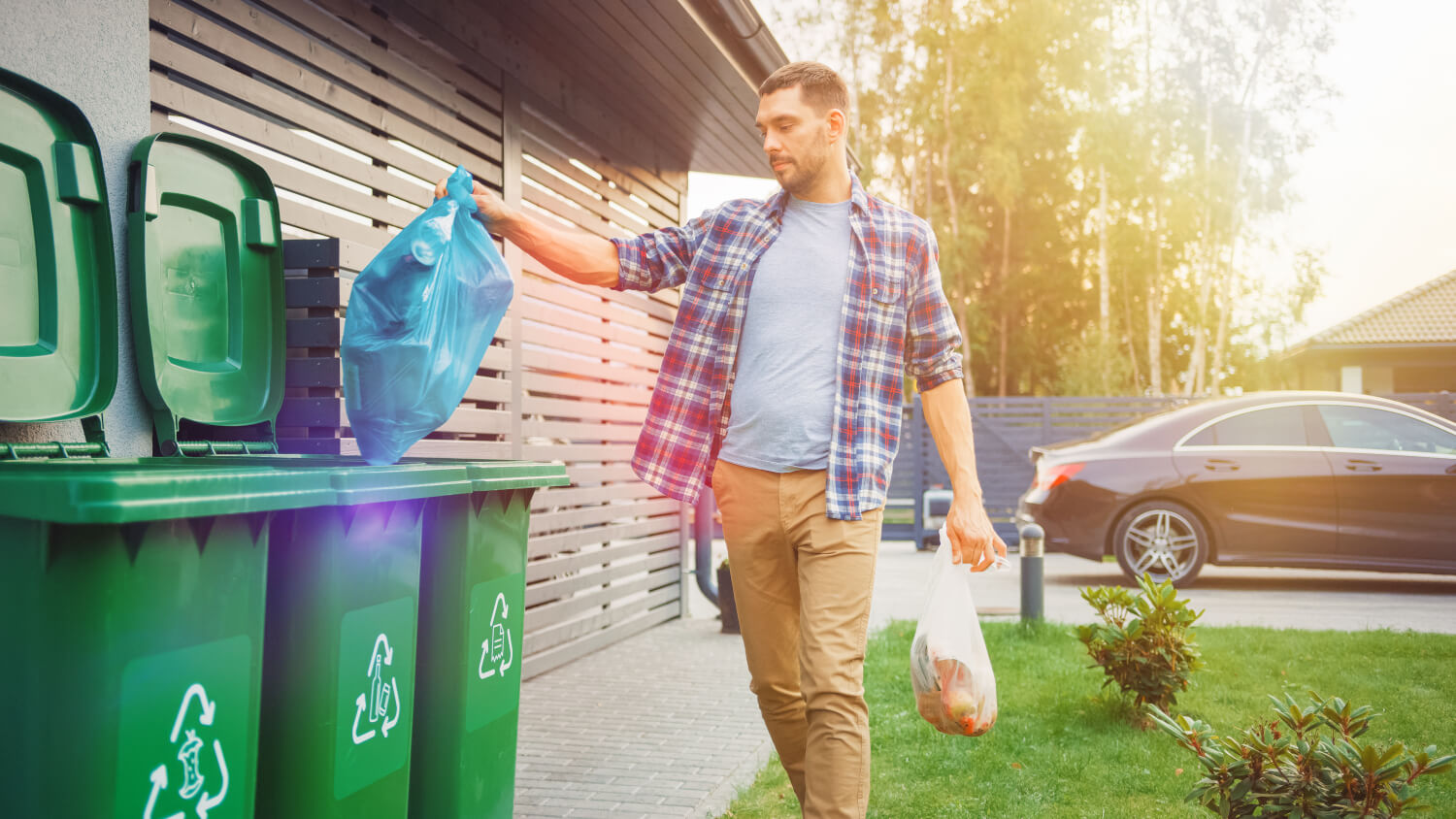Tens of thousands of pounds of trash get thrown away every day. According to the Environmental Protection Agency (EPA), the United States generated nearly 5 pounds of trash per person each day in 2018 (the most recent data available). That resulted in a total of 292.4 million tons of solid waste that year.
You might not consider where trash goes once you toss it, but the fact is that all garbage must go somewhere once the items leave your home or office. So where does the garbage go? And is there anything you can do — besides recycling — to follow environmental best practices when it comes to waste disposal?
What happens to trash?
Depending on your waste service provider, the first place trash goes once it leaves your home is typically to a waste disposal processing facility. There, the trash is sorted and categorized:
- Waste such as paper products, uneaten food, scrap metal, furniture and clothing take a variety of sorting paths depending on the item.
- Some trash is recycled or composted, while other discarded items are sent to waste-to-energy facilities.
- The remainder of trash goes to landfills.
What happens to garbage varies by region, state and city but most solid waste tends to end up at landfills in the U.S. Here’s how trash is processed at each of these facilities.
Recycling centers
The Environmental Protection Agency (EPA) estimates that around 75% of all waste is recyclable. Recycling is a preferred option for waste diversion because this reduces loads sent to landfills and conserves resources.
Reusing solid waste by turning it into new products is the goal of recycling. Recycling centers process a variety of materials, including aluminum, plastics, glass and paper.
- Glass jars and bottles, for instance, can be recycled and used for the same or similar purpose.
- Aluminum cans can be recycled and used to create more cans or even items like rain gutters and window frames.
- Plastic bottles can be recycled into a wide variety of products, including carpeting and polyester fleece.
- Paper can be recycled into new paper products.
Some recycling facilities request that customers separate recyclables by type. Modern facilities like TDS simplify this process using single-stream recycling in which all recyclables are mixed together during disposal and sorted during processing.
Recycling at TDS: Click to learn more about our Materials Recovery Facility (MRF), which uses single-stream recycling; discover what can and can’t be recycled with our Waste Wizard; give your old stuff a new life at our Citizens Convenience Center.
Composting facilities
In the United States, each person throws out about 1,200 pounds of organic garbage each year. These items could often be composted. Composting refers to the natural process of recycling food scraps and yard waste into decomposed, nutrient-rich matter that can be used to enrich the soil for gardening and agricultural purposes.
Composting, which is technically a decomposition process, is something that organically happens in nature. For example, leaves that fall in the forest eventually decompose and are absorbed into the earth. During commercial composting, this process is sped up through human intervention by providing food scraps and landscape clippings among other things to create the ideal heat and moisture conditions in which to decompose quickly.
There are several different types of composting operations, including what is considered small-scale composting, such as a home composting bin, and large-scale composting, such as what occurs at a local composting facility.
Composting at TDS: Click to learn more about the TDS United States Composting Council (USCC) certified large-scale composting efforts, including how to purchase landscaping solutions made from compost — like mulches and soil amendments — created by our affiliate, Garden-Ville.
Waste-to-energy facilities
Waste-to-energy plants burn municipal solid waste (MSW). The steam produced can be used to power an electric generator turbine. Waste-to-energy facilities reduce 2,000 pounds of garbage down to 300 to 600 pounds of ash and they reduce the volume of waste by 87%, according to the U.S. Energy Information Administration (EIA).
The most common type of combustion involves burning trash in incinerators. This process uses large industrial furnaces to burn solid waste. The method reduces the original volume of waste by 95 percent while generating surplus heat. During the combustion process, gas byproducts are captured and used to generate heat or electricity.
Another form of waste-to-energy is via anaerobic digestion. This is a biological process that uses microorganisms to convert organic materials into energy and fertilizer. The process takes place in anaerobic digesters — large tanks typically found on farms.
Landfills
Trash that can’t be recycled, composted or turned into energy is sent to landfills. Back in 2018, the EPA found that 146 million tons of waste, equaling 50 percent of the total solid waste for the year, went to landfills.
Landfills are closely monitored, out-of-the-way locations designed to safely contain and store solid waste. There are several types of landfills in North America. These include municipal solid waste landfills where most of the waste is deposited. Additionally, there are landfills dedicated to accommodating the building industry with waste created during construction, such as concrete. There are also landfills for hazardous waste and inert landfills for any other waste that needs to be disposed of such as unwanted sand or dirt.
What happens to trash in landfills?
Landfills work by storing trash in strategic ways so that the trash will decompose over time. When landfills dispose of trash, they must follow a series of regulations and steps in order to protect the environment. Your trash is compressed and stored in cells between layers of liners such as clay or reinforced plastic with a daily cover of dirt and other earth products that cover the top of exposed trash. Any leakage drains down into a sump and the process continues until a cell is full.
At the Texas Disposal Systems landfill, the structure includes both natural and manmade barriers to meet stringent environmental protection regulations. They feature a performance-based linear system with thick re-compacted clay sidewall liners and a leachate collection system for collecting liquid leakage from the trash.
The TDS Landfill: The TDS landfill, located in Creedmoor, Texas, is a fully integrated facility. Click to learn more about our transfer stations, processing, and accepted items, as well as our gate rates.
Why understanding where trash goes matters
Now that you know where trash goes after you toss it, you can be more aware of what you dispose of. Implementing waste disposal strategies at home can go a long way toward landfill diversion, which ultimately helps prevent land pollution. You can get started today and even get your community involved.
Contact Texas Disposal Systems for your waste disposal needs or visit our blog to learn more about waste disposal and resource management.
Where does trash go FAQ
Does trash get sorted at the dump?
Typically, trash gets sorted at a waste disposal processing facility. If trash is dropped off at a transfer station, it’s temporarily held and sorted there before heading to a landfill or waste-to-energy facility.
Where do garbage trucks take trash?
If you receive residential curbside services, garbage trucks will pick up your trash and transport it to a waste disposal processing facility or a transfer station. In some cases, garbage trucks will take trash directly from a collection site to a landfill if it is nearby. In addition to a landfill facility, TDS has various transfer stations located across central Texas.
Does trash end up in the ocean?
While trash in the U.S. is not deliberately dumped into the ocean, litter can still make its way to the ocean from land. Littering and illegal dumping are large contributors to both land and ocean pollution. The U.S. stopped dumping garbage into the ocean after the Ocean Dumping Ban Act of 1998 was implemented.
Texas Disposal Systems: A waste disposal partner you can trust
At Texas Disposal Systems, we recognize that we are in a unique position to help Texans dispose of their trash, recycle, and compost efficiently and effectively. We are dedicated to helping the Texas environment thrive and actively follow best practices in terms of landfill management and more. This includes:
- Diverting reusable and recyclable materials from our landfill via our Material Recovery Facilities (approximately 441,400 tons per year!)
- Use of recycled materials in the construction of roads, buildings, and topsoil initiatives across our facilities
- Large-scale, on-site composting
- Recycling and sales outlet facilities
- The planting of trees and shrubs throughout our facilities
- Supporting environmentally sound construction through our building services, including concrete recycling
- Working with local businesses, including the Barton Springs/Edwards Aquifer Conservation District, H-E-B, Austin Bergstrom International Airport, Keep Austin Beautiful, Habitat for Humanity
- And so much more!
With an eye to the present and future health of Texans, TDS strives to give Texas residents and businesses access to more holistic waste disposal solutions. Want to join us? Learn more about our residential and commercial waste collection solutions today.




